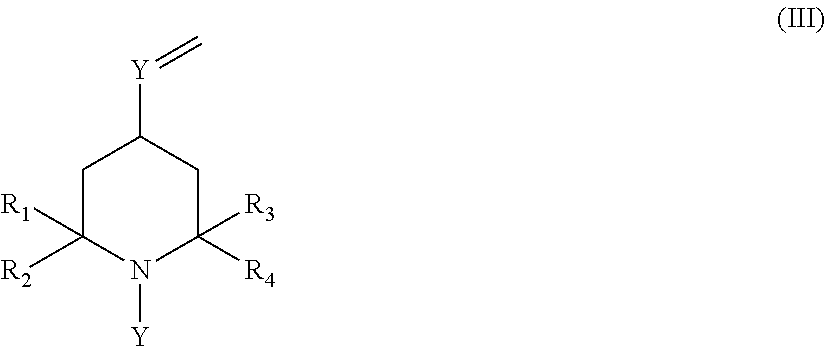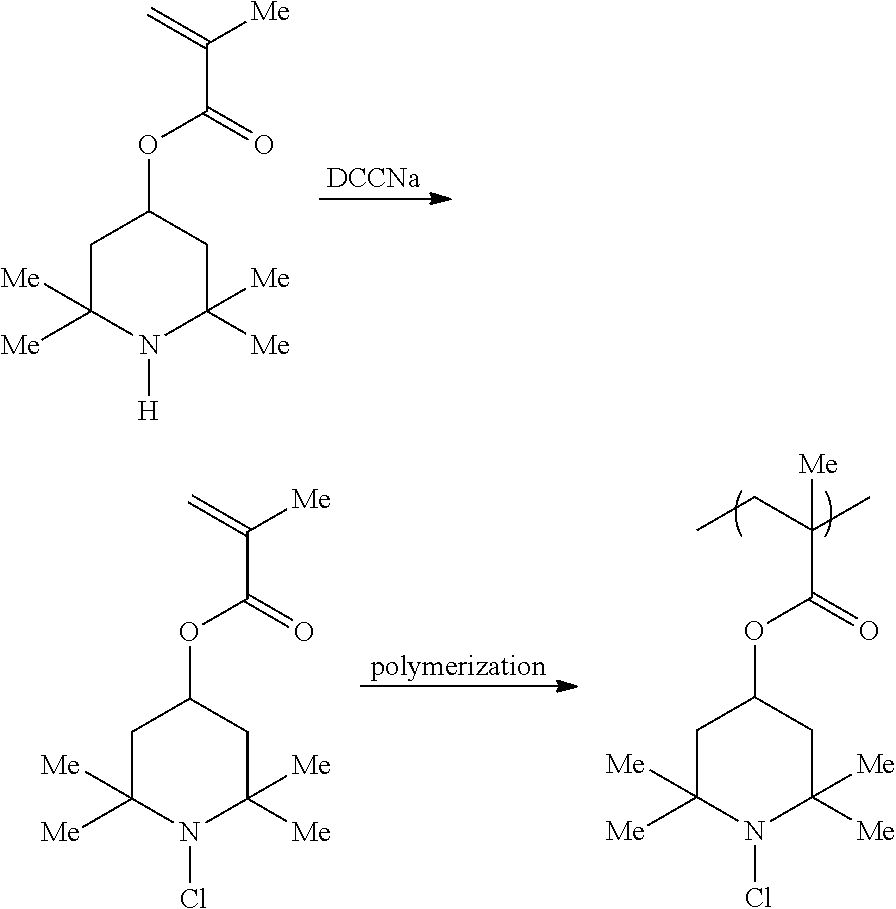Novel copolymer with cyclic halamine structure
- Summary
- Abstract
- Description
- Claims
- Application Information
AI Technical Summary
Benefits of technology
Problems solved by technology
Method used
Image
Examples
example 1
[0069]Into a 200 mL flask, 104.33 g of tetrahydrofuran (hereinafter abbreviated as “THF”), 0.17 g of lithium chloride were added, and after cooling down to −60° C., 3.37 g of n-butyllithium (15.4 wt % concentration hexane solution), and 0.81 g of diisopropyl amine were added, and the mixture was stirred for 15 min. Then, 0.87 g of methyl isobutyrate was added, followed by stirring for 15 min. Then, 15.38 g of 2,2,6,6-tetramethyl-4-piperidinyl methacrylate (hereinafter abbreviated as “TMPMA”), and 15.38 g of allyl methacrylate dissolved in 28.92 g of THF were added dropwise over 40 min, and the mixture was matured for 15 min. After the disappearance of monomers was confirmed by GC measurement of partially sampled mixture, the reaction was stopped by adding 1.2 g of methanol.
[0070]The obtained copolymer was analyzed by GPC (using THF as a mobile phase, and poly(methyl methacrylate) as a calibration standard (hereinafter abbreviated as “PMMA standard”)) to find that the molecular weigh...
example 2
[0074]Into a 200 mL flask, 90.30 g of THF, 0.16 g of lithium chloride were added, and after cooling down to −60° C., 3.25 g of n-butyllithium (15.4 wt % concentration hexane solution), and 0.83 g of diisopropyl amine were added, and the mixture was stirred for 15 min. Then, 0.84 g of methyl isobutyrate was added, followed by stirring for 15 min. Then, 15.21 g of TMPMA, and 15.21 g of glycidyl methacrylate dissolved in 28.26 g of THF were added dropwise over 40 min, and the mixture was matured for 15 min. After the disappearance of monomers was confirmed by GC measurement of partially sampled mixture, the reaction was stopped by adding 1.2 g of methanol.
[0075]The obtained copolymer was analyzed by GPC (using THF as a mobile phase, and PMMA standard) to find that the molecular weight (Mn) was 3,410, and the molecular weight distribution (Mw / Mn) was 1.24.
[0076]Water in an amount 1.25 times as much as the monomers, and ethyl acetate in an amount 1 / 9 as much as THF were added, and the mi...
example 3
[0079]Into a 200 mL flask, 97.23 g of THF, 0.34 g of lithium chloride were added, and after cooling down to −60° C., 4.8 mL of n-butyllithium (15.4 wt % concentration hexane solution), and 0.80 g of diisopropyl amine were added, and the mixture was stirred for 15 min. Then, 0.82 g of methyl isobutyrate was added, followed by stirring for 15 min. Then, 9.24 g of N-chloro-2,2,6,6-tetramethyl-4-piperidyl methacrylate, and 16.78 g of 1-ethoxyethyl methacrylate dissolved in 9.24 g of THE were added dropwise over 30 min, and the mixture was matured for 45 min. After the disappearance of monomers was confirmed by GC measurement of partially sampled mixture, the reaction was stopped by adding 1.21 g of methanol and 0.37 g of acetic acid.
[0080]The obtained polymer was analyzed by GPC (using THF as a mobile phase, and PMMA standard) to find that the molecular weight (Mn) was 3,720, and the molecular weight distribution (Mw / Mn) was 1.14.
[0081]Ethyl acetate in an amount ½ as much as THF and wat...
PUM
| Property | Measurement | Unit |
|---|---|---|
| Composition | aaaaa | aaaaa |
| Molecular weight | aaaaa | aaaaa |
| Molar ratio | aaaaa | aaaaa |
Abstract
Description
Claims
Application Information
 Login to View More
Login to View More - R&D Engineer
- R&D Manager
- IP Professional
- Industry Leading Data Capabilities
- Powerful AI technology
- Patent DNA Extraction
Browse by: Latest US Patents, China's latest patents, Technical Efficacy Thesaurus, Application Domain, Technology Topic, Popular Technical Reports.
© 2024 PatSnap. All rights reserved.Legal|Privacy policy|Modern Slavery Act Transparency Statement|Sitemap|About US| Contact US: help@patsnap.com










